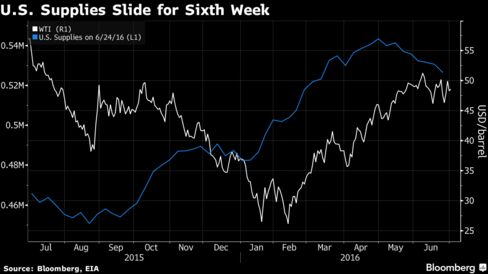Eksplorasi.id – Oil rose, following the biggest quarterly gain since 2009, amid speculation policy makers will act to limit the fallout from the U.K.’s vote to leave the European Union.
Futures climbed 1.4 percent in New York Friday after surging 26 percent during the three months ended June 30. Global markets have been in turmoil since the British referendum on June 23. U.S. crude supplies shrank a sixth week and production slipped to the lowest since September 2014, Energy Information Administration data showed Wednesday.

Supply disruptions and falling U.S. output have pushed prices up more than 75 percent from 12-year lows early this year. Canada restored production as wildfires eased and Nigeria agreed to a tentative cease-fire with militants. Pledges from central banks have halted a rout in global markets following the British decision to break with the EU, and both the International Energy Agency and OPEC forecast the oil market is heading toward a supply-demand balance.
U.S. Stockpiles
West Texas Intermediate for August delivery rose 66 cents to settle at $48.99 a barrel on the New York Mercantile Exchange. Futures climbed 2.8 percent this week, even after the contract fell 3.1 percent to settle at $48.33 on Thursday.
Brent for September settlement advanced 64 cents, or 1.3 percent, to $50.35 a barrel on the London-based ICE Futures Europe exchange. The August contract fell 1.8 percent to $49.68 a barrel before expiring Thursday. The global benchmark crude was at a 70-cent premium to WTI for September delivery.
The total volume of WTI futures traded was 29 percent below the 100-day average at 2:54 p.m. There was less activity before the three-day weekend marking the Independence Day holiday on July 4 in the U.S.
“We’re seeing paltry Friday trading ahead of a three-day weekend,” said Thomas Finlon, director of Energy Analytics Group LLC in Wellington, Florida.
U.S. crude stockpiles fell to 526.6 million barrels, the lowest since the week ended March 11, the Energy Information Administration said. Supplies climbed to an 87-year high of 543.4 million barrels in the last week of April. Production slipped by 55,000 barrels a day to 8.62 million last week, the EIA said.
Gasoline Demand
U.S. gasoline consumption fuel averaged 9.71 million barrels a day in the four weeks ended June 24, the highest seasonal level in at least a decade, according to the EIA. American motorists are projected to hit the road in record numbers during the July 4 holiday weekend, according to AAA.
“The initial shock of Brexit has worn off,” said Mark Watkins, the Park City, Utah-based regional investment manager for The Private Client Group of U.S. Bank, which oversees $128 billion of assets. “There’s a lot of driving taking place this summer. This is leading to a lot more demand for oil and a drop in crude inventories.”
Meanwhile, Norway is facing the first oil worker strike since 2012 as government-mediated talks for platform workers approach a Friday midnight deadline. Should the talks fail, more than 700 workers will walk off the job and shut about 6 percent of the oil and gas output in western Europe’s largest producer, according to the Norwegian Oil and Gas Association.
Oil-market news:
- Nymex electronic trades on July 3 and 4 will be booked with those on July 5 for settlement purposes.
- Exxon Mobil’s oil discovery off the coast of Guyana may hold as much as 1.4 billion barrels, twice the size of the previous estimate, making it potentially worth about $70 billion based on current prices.
- Iraqi crude exports fell to 3.175 million barrels a day in June, according to the nation’s oil ministry.
- Chevron may shortly give a green light to the most expensive oil project in the world this year. The company said this week in a presentation that a decision on expanding the Tengiz development in Kazakhstan will be made in mid-2016.
Eksplorasi | Bloomber | Yoko






